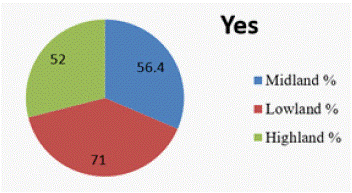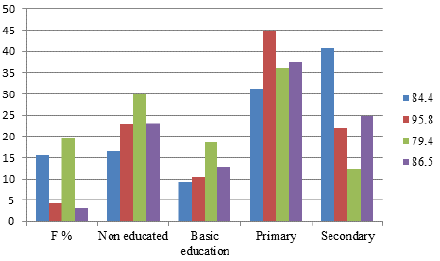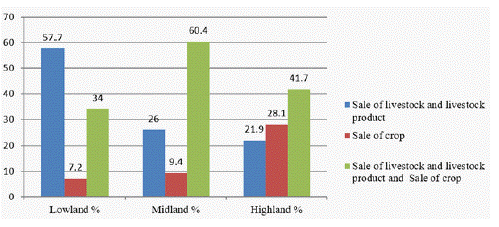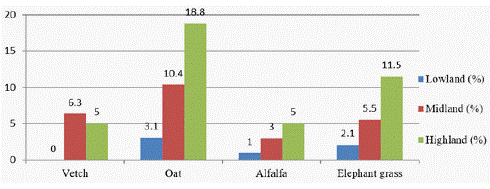Abstract
The study’s goal was to examine and rate the key livestock feed resources and their limits in Guji Zone. Data was gathered from six districts through group discussions and standardized questionnaires and also both from secondary and primary sources. A total of 288 respondents were selected at random and interviewed. Natural grassland and crop leftovers were the primary feed supplies in the research area. Drought was the leading cause of grazing land deterioration 69.1% of the lowland areas, overgrazing 58.2% of the highland areas, and bush encroachment in 21.9%. The main traditional range land management strategy in the research area was conservation enclosure (kalo). The primary source of income for stakeholders is sale of cattle and livestock products, as well as selling of crops. In comparison to the midland and highland, livestock in the lowlands travel long distances (>6 km) to get water. Further research and development should be encouraged to improve dry season feed scarcity through various options such as the use of non-traditional feeds, forage development programs, alternative crop residue utilization and adaptation, and demonstration of improved forage varieties.
Keywords: Assessment; Communal; Enclosure; Feed; Native pasture; Stubbles
Introduction
Feed is the most critical input in livestock production, and an adequate supply throughout the year is a must for any significant and sustained increase in animal output [1]. In many sections of Ethiopia, feed for animals such as natural pasture, fodder crops, fodder trees, agricultural leftovers, and non-conventional feeds are employed [2]. Feed, in terms of both quantity and quality, is the bottleneck in Ethiopian livestock output [3]. Natural pasture and crop residues have contributed approximately 56.23% and 30.06% of the shares as the principal livestock feeds accessible nationally [4], which have been influenced by diverse agro-ecologies, crop type and accessibility, and production-system [5].
Despite the importance of livestock, inadequate livestock nutrition is a widespread issue in developing nations and a major impediment to the development of viable livestock enterprises in poor countries [6]. The common difficulty with natural pasture and crop wastes is seasonal volatility in feed availability and quality difficulties, which have frequently been identified as substantial restrictions to livestock productivity in underdeveloped countries such as Ethiopia [7]. This is attributable to inadequate natural-pasture management techniques, substantial degradation in grazing regions, and the conversion and dominance of unpalatable species over the most palatable forage species of natural pasture [8]. The challenge of feed scarcity is exacerbated during the dry season [9], and fodder is insufficient to feed livestock in the highlands even during years of good rainy season [10]. Our country, Ethiopia, has the largest livestock population in Africa; however, livestock production yields are very low and are limited to contributing only about 11.48% of the total GDP [11], which is very low compared to its potential due to insufficient feed supplies and low quality of available feeds [12].
The findings of our study may help to identify existing feed utilization practices in order to find ways and means to improve these practices, as well as to define the prospects for future interventions in developing livestock feeding systems to increase productivity and the viability of the crop and livestock sectors in the study area. Likewise, there is a shortage of comprehensive information on feed resource availability, nutritional values of key feeds, current status, and potential for livestock feed production in the Guji zone, where this study was done. As a result, understanding existing feed supplies and the nutritional quality of livestock feeds will be critical for improving animal feed production and use techniques. As a consequence, the purpose of this study was to assess and evaluate main livestock feed resource usage techniques, as well as rank feeding restrictions, in the Guji zone of southern Oromia.
Material and Methods
Description of the Study Area
Guji zone is located in the southern portion of Oromia Regional State and the southeastern section of the country, covering an area of approximately 35,454 km2. Negelle, the zone's capital, is located 604 kilometers from Addis Ababa. This zone is located between 380-400 East longitude and latitude 40-50 North, with elevations ranging from 500 to 3500 meters above sea level (Guji Zone Land and Environment Protection Office, 2012). Rainfall delivery is bimodal, with the mid-lowland cultivated twice a year and the highland cultivated once a year. The zone's climate conditions are Dega, Woina dega, and Kolla, which account for 13%, 19%, and 68% of the total districts, respectively. The Zone experiences entire rainfall between March and August, and short showers between September and November, with an average annual rainfall ranging from 420 to 1400 mm (zonal report, 2002/2003).
Technique of Sampling and Sample Size
The district's locally devised organizational structure was obtained from the zonal office of the livestock development and Health (LDH) bureau. Six (6) districts were chosen from the zone based on their livestock production potential. Based on the zone's agroecology, two (2) possible highland districts, two (2) midland districts, and two (2) lowland districts were chosen. Four (4) kebeles were selected at random from each district. The requirements for choosing districts, kebeles, and farmers were diverse, including livestock population, accessibility, and experience of farmers raising animals for at least two years, with twelve (12) respondents chosen at random from each kebele. As a result, the total number of respondents for this study was 288.
Data Collection and Analysis Methods
The questionnaire was designed for responses from households to collect information’s on purposes of keeping livestock species, land holding of the households, major constraints of livestock productions, type of poisonous plant that livestock feed, types of cultivated forage species, livestock feeding systems, availability of water resources for livestock and type of agro industrial by product used for different livestock species was incorporated in questionnaire’s and carefully collected. Prior to interviewing, the questionnaires were pre-tested to see the questions construction and their validations. For responders, questionnaires were translated into the local language (Afaan Oromo). The acquired home data were summarized and analyzed using a social science statistical tool (SPSS version 16). The data were presented using descriptive statistics such as frequency, percentage and mean.
Results and Discussion
Household Socioeconomic Characteristics
Livestock production practices in the research area were classified based on several factors (Table 1). Socioeconomic characteristics of households such as gender, age, family size of homes (HHs), educational level, livestock holding, and land holding, as well as other management methods, were employed as tools. In the highlands, around 84.4% of responders were men, while 15.6% were women. In the mid-altitude, 95.8% of the responders were male, while 4.2% were female. In the lowlands, 79.8% of participants were men and 18.2% were women. Family members of HHs from the highland and the midland ranged from 44.8% to 46.9%, respectively. The educational aspect of the HHs interviewed from Highland secondary school was 40.6%, and the majority of HHs from Midland primary school was 36.1%. Oromo made up 93.8%, 84.4%, and 88.7% of the HHs interviewed in the highland, midland, and lowland regions, respectively. Participants from the study locations were Protestants in 89.6% and 70.8% of cases in the highland and midland, respectively. 39.2% of the HHS was Muslim from the researched areas' lowlands. The current study which was higher than the average family size reported by [14,5].
Agro-ecology (N=288)
Characteristics
Highland
Midland
Lowland
Ava.
Sex of HHs
M %
84.4
95.8
79.4
86.5
F %
15.6
4.2
19.8
3.2
Education level
Non educated
16.7
22.9
29.9
23.1
Basic education
9.4
10.4
18.6
12.8
Primary
31.2
44.8
36.1
37.6
Secondary
40.6
21.9
12.4
24.9
Above secondary
2.1
21.9
2.1
8.76
Family members
1-5
25
24
27.8
25.6
6-10
44.8
46.9
43.3
45
11-15
24
18.8
18.6
0.5
Above- 15
5.2
8.3
9.3
7.6
Ethnic group H/Hs
Oromo
93.8
84.4
88.7
88.9
Somale
3.1
1
7.2
3.8
Others
3.1
14.6
3.1
6.9
Religion of H/Hs
Orthodox
4.2
18.8
12.4
11.4
Muslim
2.1
8.3
39.2
16.5
Protestant
89.6
70.8
38.1
66
Others
3.1
2.1
7.2
4.2
Table 1: Shows the gender, age, family size, and educational level of the household.
The Role of Livestock Holding
The average number of sheep reared for subsistence in the highland parts was higher than in the other midland and lowland agroecology, and the majority of them were indigenous types (Table 2). Sheep and goats were mostly raised for meat and revenue. Goats are particularly essential to lowland farmers because they may provide a significant quantity of protein from animals in the form of meat and milk. Generally, livestock in the study area were not reared for single purpose rather for multi-purpose which was in corroborated with the study of [16,14].
Livestock herd structure
Highland %
Midland %
Lowland %
Ave.
Calve male less 1 year (TLU)
87
66
92
81.7
Calve female less 1year (TLU)
65
57
85
69
Heifers (TLU)
63
33
93
63
Bull (TLU)
55
39
89
61
Oxen (TLU)
53
60
85
66
Dry cow (TLU)
67
34
88
63
Lactating) cows (TLU)
82
66
90
79.3
Sheep (TLU)
74
31
60
55
Goat (TLU)
19
39
86
85.7
Camel (TLU)
-
-
4
24.7
Donkey
7
52
65
41.3
Mule (TLU)
31
11
9
16.3
Poultry (TLU)
65
68
61
64.7
Number of boney bee (Hives)
62
63
43
56
Table 2: Shows the structure of livestock herds.
Important Livestock Feed Resources
Natural grassland, agricultural leftovers, stubble, grazing from fallow areas, forests, and shrub lands are the main feed resources for cattle in the district (Table 6). Natural grassland and agricultural leftovers are the most important feed resources for cattle in the research area, as they are in most developing nations [6].
Natural Pasture
Management and ownership practices: There are various types of grazing fields in the study sites, including private and communal land. There are also animals from browse tresses, stubble grazing, and riverfront grazing meadows (chart 1). Natural pasture supplied more than half of the animal feed, supporting the widespread notion that natural pasture is a key source of animal feed [13]. The natural pasture was ranked as the principal source of feed for cattle by 52% of the studied households in the highland, 56.4% in the midland, and 71% in the lowland. Chart 1 shows the percentage of respondents who use enclosures (private grazing fields) as animal feed in the various agroecology of the research locations.

Char 1:
Following the commencement of rain, grazing on both private and communal grazing land was widespread practice in most parts of the research region (Chart 1). The midland portion of the examined houses was privately owned (56.4%). The remainders were found along the riverbank and among the browse trees. During the wet season, animals were not allowed to graze on private grazing land; instead, they were allowed to graze on poor herbage found along the roadside and in communal grazing area. In July, 70.8% of respondents from the highlands closed their private grazing pasture. Once it was regenerated and had more covering, and biomass began to be utilized from late August to October, 68% and 22% of respondents from lowland areas stop their own private grazing property beginning in April and September, respectively, and employ their grazing land beginning in June and ending in August.
There was no restriction on the use of communal grazing land by the animals of farmers living in the same peasant association at any time, but access to private grazing land by owners of other farmers' animals was limited to a specific time of year from (July to late August) based on group discussion. As a result, authorization to use the private grazing property by animals belonging to other farmers is only granted once the owner's animals have grazed a sufficient amount of the herbage. As a result, more than 40.2% of lowland, 41.2% of midland, and 47.2% of highland households prioritized calf and dairy feeding over private grazing land (enclosure) and crop leftovers plus other feed. Pregnant animals and oxen were also given preference when it came to feeding crop leftovers and other feed (Table 3).
Priority of livestock type given
Lowland (%)
Midland (%)
Highland (%)
Calves
41.2
17.7
20.8
Pregnant cow
9.3
5.2
5.2
Lactating cow
40.2
22.9
42.7
Bull
9.3
2.1
Oxen
-
54.2
19.2
Table 3: Shows priority of livestock nutrition.
The Factors that Contribute to Grazing Land Degradation
The root causes of animal feed shortages in the research area differ from one agroecology to another (Chart 2). Rainfall was pointed out by 69.1% of respondents from the lowland, overgrazing was identified by 47.9% of respondents from the midland, and insufficient grass was mentioned by 58.2% of respondents from the highland as the reason for feed deficit.

Chart 2: The cause of grazing land degradation

Chart 3: Shows the respondents' primary source of income.
Crop residues
During the rainy season, crop remains were used to augment the limited nutrients acquired from communal grazing areas (Table 4). According to information acquired from group conversations, crop residue feeding begins in February and continues until July shortly after crop threshing, primarily in highland areas. Crop residue is the second (2nd) most common source of livestock feed for 40.6% of crop producers in the study areas, including 40.6% from the highlands, 39.9% from the midlands, and 15.5% from the lowlands. Crop residue from different crops (tef, maize, wheat, barley) was fed to livestock by 40.6% and 39.6% of highland and midland respondents, respectively. In general, crop residues and natural pasture are the major feed resources of the study area which was agreed with the result of [16,14].
Feed recourses available
Lowland (%)
Midland (%)
Highland (%)
Natural pasture (grass from grassland)
79.5
55.3
52.0
Crop residue (maize stove, wheat/barley straw)
15.5
39.6
40.6
Fodder tree
3.1
3.1
4.2
Stubble grazing
-
2.1
2.1
Improved forage varieties
-
-
-
Table 4: Shows the major Livestock feed resource of the study area.
In accordance with the HHs interviewed in the study area, 52%, 14%, and 44% of the lowland, midland, and highland areas, respectively, use natural pasture during the Ganna season (Table 5). Throughout the year, 100% of households in the study area's highlands use natural pastures. In the study area, the dry season caused a significant feed scarcity. During the dry season, the lowland and midland districts experienced acute feed shortages.
Season
Lowland %
Midland %
Highland %
Ganna
52
14
44
Bona
35.1
44.8
56.3
All the year
41.2
53.1
100.0
Season of critical feed shortage
Ganna
9.3
5.2
10.4
Bira
3.1
9.4
7.3
Badhessa
1
22.9
6.3
Dry
85.6
57.3
50.0
Table 5: Shows the season in which natural pasture is used.
The primary sources of income for respondents from the study area are sales of livestock and livestock products (58.7% from the lowland), sales of livestock and livestock products and crops (62.5% from the midland), and sales of livestock and livestock products and crops (49% from the highland).
The current study's critical traditional range land management practices (Table 6) were the conservation of grazing area (kalo) 38.1% from the lowland and 37.5% from the highland, conservation of hay, straw, and others 49% from the midland areas.
Major activity performed of traditional rangeland management practice
Lowland (%)
Midland (%)
Highland (%)
Conservation of grazing area (kalo)
38.1
14.5
27.1
Conservation of crop residues (hay, straw and others)
18.6
49.0
34.4
Moving animals to abundant feed during dry season (rotational grazing)
36.1
34.4
37.5
Migration to other relatives
35.4
2.1
-
Burning of grazing lands (bush and tick control)
-
-
1.0
Table 6: Shows respondents' typical rangeland management practices.
Improved Forage Growth and Utilization
During the dry seasons, 18.8% and 10.4% of the studied households in the midland and highland have used improved forages to feed cattle in the form of cut and carry. Farmers may employ low forage due to a lack of land, a lack of forage seeds, and a lack of awareness about the necessity of enhanced forage species. In other words, cultivated forage species are not widely produced in the study area. However, attempts were made to improve the supply and quality of traditional forage in the zone (chart 4). But, very small proportions of the house hold were practicing for improved forage to alleviate feed shortage and the study was in line with the result of (Feyisa, and Dejen, 2017).

Chart 4: Use of improved forage,
Animal Health Issue Related to Feed
Feed-related animal health issues occurred in high and medium agroecology as well. Grazing fields have a substantial amount of Trifolium species that were grazed prior to full blossoming during the wet season, which may cause rumen bloating in animals. This investigation is consistent with the findings of [14]. Bloating was common and affected animals frequently perished within a short period of time, especially during the mid-wet season. The study area contained poisonous plants which affect animals such as Bati, Qobboo, Furfura, Abbayi, and Quru (Table 7).
Agro-ecology
Categories
Percentage (%)
Highland
Beginning of wet season
19
Mid of wet season
45.5
End of wet season
35.5
Midland
Beginning of wet season
42.0
Mid of wet season
35.0
End of wet season
33.0
Lowland
Beginning of wet season
30
Mid of wet season
70.0
End of wet season
-
Table 7: Shows the frequency of bloating in the research sites during different seasons.
When bloating occurs in animals, most farmers interviewed employ conventional therapies such as providing Araki (local beverages) and food oil. They keep grazing animals away from Trifolium pasture during the vegetative growth stages as one strategy for preventing and reducing bloating problems. Furthermore, feeding animals hay and straws before they begin grazing is recommended to lower the risk of bloating, according to the study [14].
Water Management
Watering frequency of various animal species (Table 8), the majority of farmers interviewed in all agro-ecology animals watered once a day, yet 31%, 57.1 %, and 39.8% of farmers supplied water twice a day in the highland, midland, and lowland areas, respectively, during the dry season. Among livestock keepers, 43% of farmers were able to provide appropriate water in the highlands. Longer distance in the zone indicated that herds were wasting much of their energy in travelling to and from the watering points in the current study was in line with the result of is [14].
Categories
Watering frequency
Highland (%)
Midland (%)
Lowland (%)
Cattles
Adequately
43
23.7
32.4
Once in a day
31
57.1
39.8
Twice in a day
15
10
27.8
>Twice in a day
11
9.2
-
Small ruminants
Adequately
56.5
7.3
29.2
Once in a day
25
64.6
70.8
Twice in a day
11.5
18.8
-
>Twice in a day
7
9.3
-
Equines
Adequately
87.5
42
15.5
Once in a day
8.4
26.7
56.7
Twice in a day
1.0
23
27.8
>Twice in a day
3.1
8.3
-
Table 8: Percentage of respondents in the research area that water their animals at various frequencies during the dry season.
Likewise, animals in the lowland area traveled a greater distance (> 6 km) to access water spots than in the midland and highland areas (Table 13).
Chart 5 Percentage of respondents traveling various distances to watering locations during the dry season

Chart 5:
During the dry season, the principal sources of water in all agro-ecology were ponds, followed by springs. During the wet season, however, rivers were the primary source of water in the highland, while ponds were the primary source of water in both the midland and lowland (Chart 5).
Conclusion and Recommendations
An assessment of key livestock feed resource consumption and constraint practices in highland and midland agroecology mixed-crop livestock and lowland livestock production systems were undertaken in this study. Agroecology and crop production are frequent in the mixed agricultural systems of the highlands and midlands, and day-to-day activities of the people and cattle rearing were the main activities of the lowland pastoralist. Cattle are the most significant livestock species for household tasks such as agriculture, threshing, transporting, and income generation. With poor resource management, communal and private pastures were the primary source of animal feed. The study area's feed resources included natural grassland, agricultural residues, crop stubbles, and browsing trees. Overall, the principal limits to livestock production and productivity can be summarized as feed shortage, drought, overgrazing, and inefficient use of feed and feed resources as a result of a large number of cattle, which exacerbated the situation. As a result, the following points are suggested to sustain the production system in the study area:Enhance the current state of communal rangelands through degraded area management and awareness creation.
Additional research and development should be encouraged to alleviate dry season feed shortages through various choices such as the use of non-conventional feeds, forage development programs, irrigation, alternative crop residue usage methods, and conservation techniques.
Farmers should be provided with powerful extension services for feed resource development, as well as training in basic principles of collecting; storing harvested feed resources and agricultural residues.
References
- Legesse Getahun, Marianna Siegmund-Schultze, Girma Abebe, and Anne Valle Zárate. Economic performance of small ruminants in mixed-farming systems of Southern Ethiopia. Tropical animal health and production. 2010; 42: 1531-1539.
- Sefa Salo. Estimation of feeds and fodders for livestock population of Ethiopia and mitigation of feed shortage. J Nat Sci Res. 2017; 7: 45-51.
- Alemayehu Mengistu, Gezahagn Kebede, Fekede Feyisa, Getnet Aasseffa. Review on major feed resources in Ethiopia: conditions, challenges and opportunities. Agricultural Science and Research. 2017; 5: 176-185.
- CSA (Central Statistical Authority). Agriculture Sample Survey. Report on Livestock and Livestock characteristics, Addis Ababa, Ethiopia. 2015.
- Ahmed Hassen, Abule Ebro, Mohammed Kurtu, Tredate AC. Livestock feed resources utilization and management as influenced by altitude in the central high lands of Ethiopia. Ethiopia. Livestock Research for Rural Develoment. 2010; 22.
- Sere C, Ayantunde A, Duncan A, Freeman A, Herero M, Tarawali S, et al. Livestock production and poverty alleviation-challenges and opportunities in arid and semi-arid tropical rangeland-based systems. 2008.
- Teferi Admasu, Erbo Abule, Zewudu Tessema. Livestock-rangeland management practices and community perceptions towards rangeland degradation in Southern omo zone of Southern Ethiopia. Livestock Res Rural Dev. 2010; 22.
- SNNPRS (Southern nation Nationalities and Peoples Regional state). The southern nation Nationalities and peoples regional state resource potential and investment opportunities, Hawassa, Ethiopia. 2008.
- Zewdie Wondatir. Livestock production systems in relation with feed availability in the highlands and central rift valley of Ethiopia. An MSc thesis presented to Haramaya University. 2010; 160.
- Melese Gashu, Berhan Tamir, Mengistu Urge. Effect of supplementation with non-conventional feeds on feed intake and body weight change of Washera sheep fed urea treated finger millet straw. Greener Journal of Agricultural Science. 2014; 4: 067-074.
- MoFED (Ethiopia Ministry of Finance and Economic Development). National Accounts statistics (GDP) Estimates, Addis Ababa, Ethiopia. 2010.
- CSA (Central Statistical Agency). Agricultural sample survey report on livestock and livestock characteristics. Statistical Bulletin. Addis Ababa, Ethiopia. 2010; 532.
- Lemma Gizachew. Crude protein and mineral status of Forages grown on pelvic vertisol of Ginchi, central highlands of Ethiopia. PhD dissertation Presented to the University of the Free State, Bloemfontein. 2002.
- Feyisa Tesfaye, Dejen Melles. Assessment of major livestock feed resources and feeding systems in Bench-Maji zone; South Western part of Ethiopia. Online J Anim Feed Res. 2017; 7: 145-153.
- Dawit Abate, Ajebu Nurfeta, Sandip Benerjee. Assessment of feed resource availability and livestock production constraints in selected Kebeles of Adami Tullu Jiddo Kombolcha District. Adami Tullu Agricultural Research Center, Ziway, Ethiopia. Academic Journals. 2013; 8: 4067-4073.
- Chufa Amba, Tadele Yilkal, Hidosa Denbela. Assessment on Livestock Feed Resources and Utilization Practices in Derashe Special District, Southern-Western Ethiopia: Status, Challenges and Opportunities. J Vet Med Animal Sci. 2022; 5: 1110.
